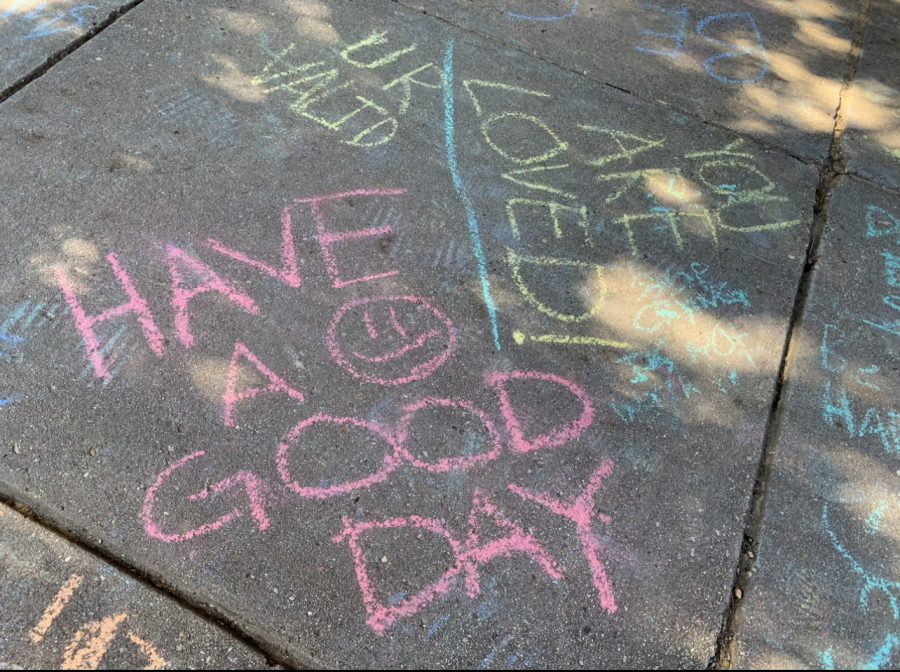MCPS strives to bridge mental health resources with students
As a part of Mental Health Awareness Week, students drew positie messages in the bus loop on Oct. 11 during lunch. These activities are another one of WCHS’s efforts to push for better student wellness.
October 20, 2022
For most students, high school leads to a lot of stress. Between class assignments, homework, extracurricular activities and more, it can be difficult for students to stay afloat. This added stress worsens mental health, a trend that has increased drastically over the pandemic. As mental health continued to decline in students, MCPS knew that they needed a plan to help combat this growing issue. So, a new initiative was created: Bridge to Wellness.
MCPS has always emphasized initiatives to improve mental health in students. Especially after COVID-19, many new policies and programs were introduced with the goal of supporting students. Bridge to Wellness is a new program where physical wellness centers will be put in all MCPS high schools. Six high schools across the county already have fully operating wellness centers where students can go for mental health support. The goal of Bridge to Wellness is to expand these programs to all high schools.
“With the uptake in mental health concerns among teenagers, the county council wanted to address these problems in a significant way,” WCHS principal John Taylor said. “The solution they came up with is a program called Bridge to Wellness. With this program, they funded putting physical wellness centers in every [MCPS] high school and each school is partnering with a mental health provider in the community to have assigned staff in the buildings to work with kids.”
In the wellness centers, there will be full time staff members who provide mental health services such as therapy and crisis support. Currently, MCPS is working to train specialized staff as they prepare for the opening of wellness centers. Staff positions include mental health clinicians, care managers and youth development staffers.
“What they have described to us is that there will be three full time staff members in each wellness center,” Taylor said. “Two of whom are doing case management and will have an assigned group of students that they work with on a regular basis. The other is a full time therapist who will be meeting with kids all day long and doing therapy during school hours. At WCHS we currently have one staff member for the wellness center hired, Mr. Elliot, who is already working with students and eventually we will have three full time people.”
Staff in the wellness centers will be focused on working with specific groups of identified students who need more support than others. These students can then be evaluated for what support is most beneficial depending on their situation, such as a meeting about attendance, a home visit to talk with parents about what is going on or working one-on-one with a student.
“The wellness centers are mainly for students who do not have access to resources outside of school that really need them,” WCHS social worker Gretchen Glick said. “The support provided is aimed to benefit students who are having crises in the building, and not so much those who regularly see a therapist outside of school.”
From an outside perspective, it can be difficult to see how the wellness centers differ from the health room or the counseling offices. Many of the already existing wellness centers include a medical clinic and all wellness centers have mental health support, something that may seem similar to the health room and counseling offices respectively. However, they serve different purposes.
“The health room has a nurse and a technician who mainly check vitals and physical injury,” Glick said. “The counseling office is where students go concerning classes and maybe to discuss issues they are having, but does not have a vast extent of mental health support compared to the wellness centers. The wellness centers differ because they will focus on social-emotional health. Wellness centers address mental health issues and are a liaison to the county for people who need more serious help.”
As Bridge to Wellness is being implemented in 19 high schools across the county, many factors will vary from school to school. Some schools may have a high demand for mental health support, while others may only have a handful of students who need the services. Although the need for mental health assistance may differ, it is clear that wellness centers will greatly benefit students.
“Every school is different, but I think at WCHS we are probably going to have more kids that need short-term support and not so many kids that are going to need it all four years,” Taylor said. “The unfortunate double edged sword of WCHS is that we have amazing, high-performing kids, but there is a lot of stress and anxiety to go along with that. Managing all that stress when you are a teenager can be hard to handle so the wellness center is there to provide that additional mental health support.”
In April 2022, the Montgomery County Council approved an $8 million budget to fund the expansion of wellness centers. While the original six wellness centers at other MCPS high schools are large, extensive facilities that have been in use for years, the new wellness centers being added to the rest of high schools are going to be smaller and less elaborate, most of them simply being repurposed classrooms.
“The wellness center at WCHS will be in room 124, which is located down the math hallway and near the auditorium,” Taylor said. “124 is a smaller classroom originally designed as a meeting room so we converted it to where the actual wellness offices will be. The class will consist of a meeting space and two offices.”
Although Bridge to Wellness will be focused on creating smaller wellness centers, many are still optimistic that the program will have a positive impact on students, especially to those who need the specialized support. As of now, MCPS is expecting to have all wellness centers fully staffed and ready for student use by the end of October.
“I think the wellness center at WCHS is really going to give us a lot of resources that we did not have previously to address mental health concerns,” Taylor said. “Having a support system in school is going to make it more equitable and fair to students who do not have access to these resources outside of school. It is going to make it easier for kids to get the help that they need and I think that is really important.”



